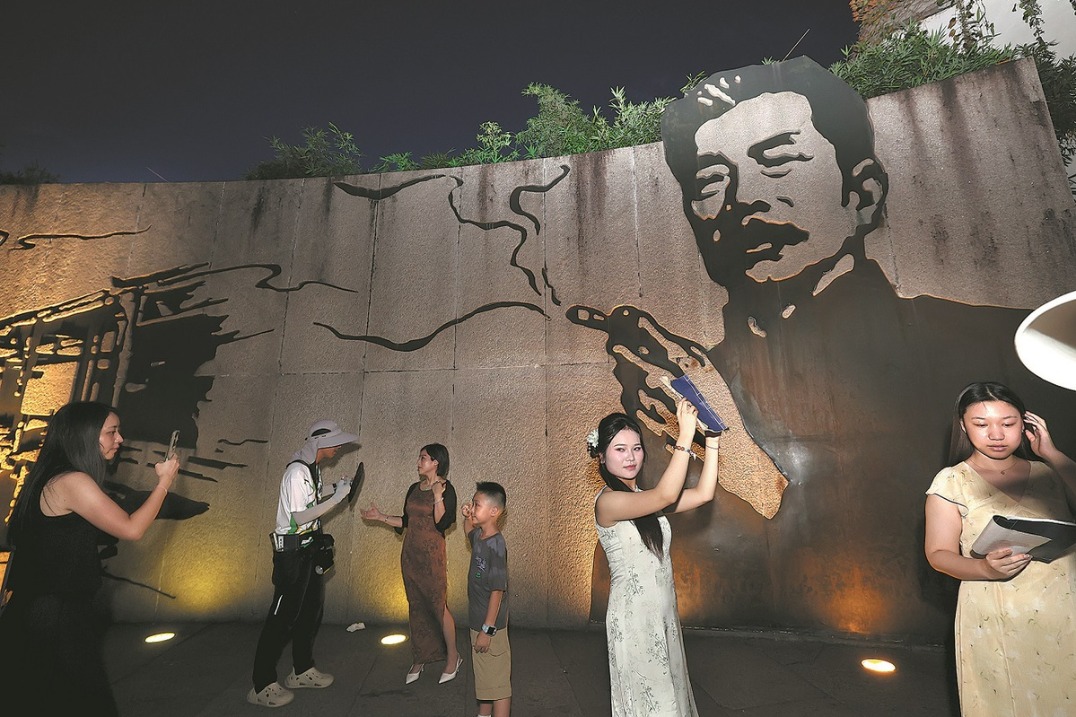Fish skin and bones give ethnic group a tale to tell

HARBIN — If you haven't tuned into Wang Haizhu's livestreams, it might be hard to believe that fish skin and bones can be transformed into paintings, jewelry and even clothing.
"The Hezhe people traditionally used fish skin and bones to make clothes, shoes and decorations due to their fishing heritage," says Wang, a 46-year-old artisan from Bacha village in Tongjiang city, Northeast China's Heilongjiang province.
Wang is from the Hezhe ethnic group, which was once the only fishing and hunting community in northern China. They reside along the Heilong, Songhua and Wusuli rivers, with their fishing traditions dating back to the Neolithic Age.
Although fish-skin clothes and shoes are no longer daily necessities, they have become fascinating works of art, breathing new life into the Hezhe culture and showcasing its rich heritage.
In 2016, Wang embarked on a systematic study of the fish-skin craft, which is recognized as a national intangible cultural heritage.
Drawing on skills acquired since childhood, she saw the opportunity to modernize these traditions to suit contemporary tastes and founded a cooperative with several other local residents.
At her cooperative, tables are adorned with an array of handcrafted items made from fish skin and bones, ranging from earrings and necklaces to handbags and shawls.
"We now have more diverse designs," Wang says.
"In the past, we mainly created motifs reflecting Hezhe life, such as the sun, the moon and trees. Now, our designs cater to customer preferences, including motifs like Chinese zodiac animals."
Wang regularly hosts livestreams to promote local crafts, sharing the history and stories behind these creations with people from all over the country.
About 100 people in Wang's village are skilled in the fish-skin craft, most of whom are females.
Tongjiang, a county-level city with over 170,000 residents, is one of the main settlements of the Hezhe ethnic group. Since the beginning of this year, it has received 614,000 tourists, up 11.9 percent year-on-year.
The Hezhe people have observed remarkable transformations in their living conditions, as modern villas, sleek asphalt streets and cars have replaced straw houses, dirt roads and carriages.
What endures unchanged is the fervor of this ethnic community for traditional arts, exemplified by Yimakan, a distinctive form of storytelling that teetered on the edge of extinction.
Yimakan reflects the ancient history, fishing and hunting life, love stories and customs of the Hezhe people. It is regarded as a living fossil and an encyclopedia of the Hezhe culture, according to Wu Guifeng, a renowned Yimakan storyteller.
Yimakan performances are solo acts that blend narrative and singing, primarily focused on storytelling, accompanied by song and devoid of instrumental backing.
According to official data, there are six centers dedicated to the study and practice of Yimakan storytelling in Heilongjiang, with participants ranging from elderly people to primary school students.
Traditional festivals like Wurigong combine traditional music, dance, narrative art and sports, serving as grand showcases of Hezhe culture.
Many schools in Tongjiang have also launched courses focused on fish-skin ornament making.
Qin Wenpeng, an expert on the study of ethnic groups at the Heilongjiang Provincial Academy of Social Sciences, says Tongjiang's efforts to preserve traditional culture exemplify the balance of economic and cultural development.
In recent decades, rapid advancements in financial status and improvements in healthcare have contributed to the remarkable population growth of this ethnic group, surging from just over 300 to more than 5,300.
As an inheritor of the fish-skin art, Wang says she feels a sense of responsibility to ensure that more people learn about the Hezhe culture.
Xinhua
Today's Top News
- SCO Summit: A shared vision for trust, equality and prosperity
- SCO to chart course for a shared future
- How Xi pushes for building common home of peace for SCO
- Xi says China, Kazakhstan reliable partners for each other
- Xi meets Nepali prime minister
- Xi meets Cambodian prime minister






























